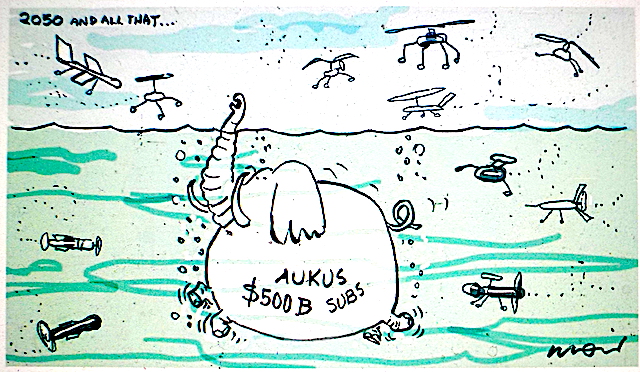Search
Democracy Links
Member's Off-site Blogs
non-peaceful submarines.....
The multi-billion dollar expenditure on nuclear powered submarines as part of the AUKUS pact has attracted some attention. Perhaps it helps to provide historical context if it is remembered that Australia’s first submarines were of limited use in the defence of our shorelines.
Submarines then and to come By Tony Smith
My four times great grandfather William Eckford from North Ayrshire was a gunner in the British navy until he emigrated in 1800. He had several brothers including Henry who went to Canada to work with maternal uncle John Black. Henry became a famed naval architect and was involved in Democratic Party politics in New York. He then accepted a contract to build up the Sultan’s Ottoman fleet but when he went to Turkey, he contracted an exotic fatal disease and died in 1832.
I mention this personal anecdote because of two submarines the British sold to the Australian navy during the first world war the AE2 also met its end in Turkey, in 1915. The submarine achieved quite a feat by breaching the minefield and netting across the Dardanelles. When the war became too hot however, the skipper scuttled the vessel and the crew spent the rest of the war as prisoners in Turkey.
No doubt the British sold Australia the submarines for their own strategic benefit. Australia was Britain’s deputy down under and there were some obvious targets in the Pacific region, especially German colonies in and around New Guinea. The submarines, stationed in Sydney were named prosaically the AE 1 and AE 2.
The fate of the AE 1 remained a mystery until quite recently. It left Sydney in 1914 and disappeared. There were various theories about its fate and that of the crew of 35 including 14 from the Australian navy. One rumour had the submarine appearing off the Tolai Peninsula and being called a ‘devil fish’ by locals. Ultimately this location proved to be accurate when the wreck was discovered in 2017.
War fever was strong in Australia in the 1914-18 period. When mothers lost sons, some sanctimonious patriots went so far as to tell them not to mourn, but to wish they had more sons to sacrifice for the holy cause of Motherland Britain. This makes all the more remarkable, the war doubting poems of Leon Gellert, Mary Gilmore, Mary Fullerton and others.
Nina Murdoch should be included among these heroic peace activists, especially for her ‘Coloured Bows’ from the collection Songs of the Open Air. Murdoch was well known to baby-boomers because of her role in the production of the ABC participatory radio program ‘The Argonauts’.
Apparently at the Sydney naval base, women with husbands, relatives and friends aboard the various ships identified themselves by the colour of ribbons they wore. The refrain of Murdoch’s poem runs:
‘It’s red for the Australian, The little Penguin’s blue
It’s white for the Encounter and the Sydney’s purple hue
But it’s black plain black if your husband or your son
Sailed out of Sydney on the A.E. One’.
In the ‘nuclear age’ submarines create more than a little alarm among peace activists. During the women’s camps at Greenham Common songs and chants were created to express opposition to these deadly weapons. Adrian Mitchell’s in his book of poetry Love Songs of World War Three (1988) used the tune of several Beatles’ songs including ‘Yellow Submarine’. The lyrics he provided for the peace campers ran:
‘In the town where I was born
Lived a man who served the Queen
And he told me of his work
In a killer submarine’.
More recently, anti-Aukus protestors in Sydney have set relevant lyrics to well known tunes including a song for the Raucous Anti-AUKUS Chorus by Jenny Fitz to ‘Oh My Darling Clementine’. Thanks to Margaret Walters for this song and others.
‘Let’s be raucous, No to AUKUS, and to nuclear submarines
To the Alliance, show defiance
No to AUKUS ‘n’ submarines.
Let’s be raucous, No to AUKUS, and to nuclear submarines
The price will blow out, waste will flow out
No to AUKUS ‘n’ submarines’.
There is something sinister about submarines. Their primary purpose is to fire torpedos at shipping and missiles onto land targets. It is difficult to separate them from sudden terror attacks. Their role in supposed deterrence is negligible because they ‘run silent, run deep’. Their task is always to threaten. While some naval vessels could have essentially peaceful purposes, it is difficult to envisage such a role for submarines. They are never part of the shield, but always a spearhead. It seems significant that only a male could want to own a submarine.
https://johnmenadue.com/submarines-then-and-to-come/
FREE JULIAN ASSANGE NOW..................
Cartoon from MOIR, SMH, 2 March 2024....
- By Gus Leonisky at 3 Mar 2024 - 4:53am
- Gus Leonisky's blog
- Login or register to post comments

Recent comments
51 sec ago
2 hours 7 min ago
6 hours 13 sec ago
6 hours 58 min ago
7 hours 14 min ago
7 hours 31 min ago
7 hours 50 min ago
8 hours 18 min ago
1 day 10 hours ago
1 day 11 hours ago